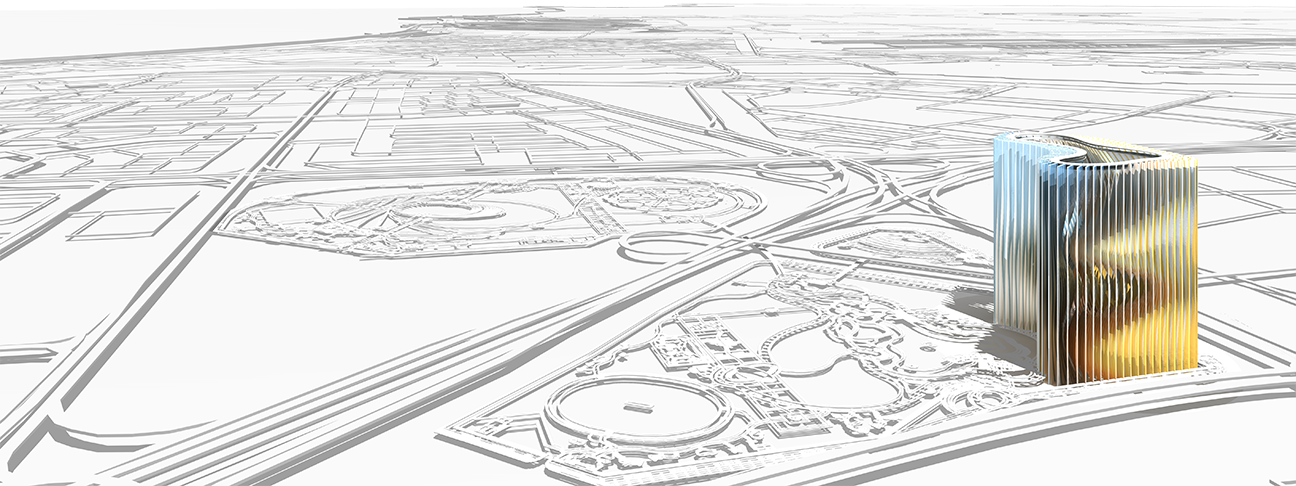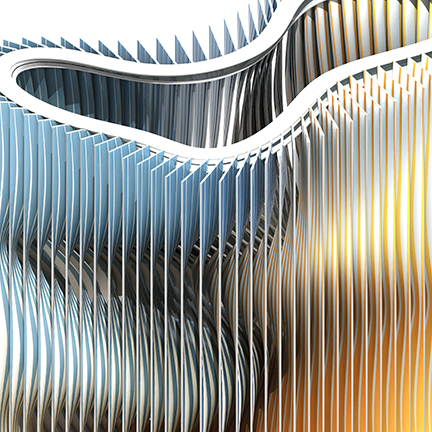
Dubai Tall Emblem Structure
Open Competition Entry _2008
“Dubai” Or: Shall architecture be always nice to everyone?
with Hessamedin Fana, Sahand Ahmadian, Mojtaba Samimi, Babak Afshar & Mohammad Ekhlasi
The project is an entry to the open competition for a tall emblem structure to “promote the new face of Dubai and serve to ascend tourism and other recreational, scientific and cultural activities as well”. Architects in different parts of competition conditions were asked to design something “iconic” to “provide a meaning and symbolize the significant new face of Dubai and/or refer to its historical development”.
We took that lead but in our own way:

First, Dubai is a city between two deserts: salty sea on one side and a burning barren landscape on the other, have caused an undesirable humid and hot climate. The only way Dubai could grow this large was to technically push back these two dominant deserts. The city is leaning on a vast network of district cooling systems and clusters of desalination units; so we based our design upon this condition in which a city bubbles up on the borderline between two deserts, fights with them and deriving its form from them.
[rev_slider alias=”Ortho Elevation”][/rev_slider]
Second, Dubai is the city of grand desires, city of “-est”s. The world’s largest artificial islands and off-shore settlements on one hand and the longest man-made canals on the other, have evolved the coastline into a dominant urban plan element; also the urban sections have been swarmed by the tallest skyscrapers founded on the deepest pilings. This constantly refreshing illusion between desert and sea has been decorated with an arsenal of Guinness record breaking projects which seem to be the most convincing testimonials of respect to modern life.

Third, is the futility of the whole Dubai’s development process. Except that a group of people have decided (rightfully of course) to bombastically develop their ancestral homeland, which is happened to be the rooftop of a hot and humid oil tank, nothing else could justify the grotesquery of the cultural and environmental harms being imposed. Asking architects to “provide a meaning” for this geo-strategic mojo or to superficially “refer to its historical development” cannot be part of the requirements for any serious project.

• observation deck interior with the view over the city through the blue/yellow fin walls.

The proposal is conceived as 80 fin walls standing at the height of 170 meters, erected around the site. Each fin, with two different faces of yellow and blue, connects from inside, a non-uniform curve on a free-form central void to an upright curve on the exterior, originating from the extrusion of the site perimeter.
The whole oneiric exterior image of the structure is but an illusion caused by a parallax of the internal and the external edges of the collection of fins. The structure constantly reflects altering and ambiguous manifestations of what’s within to the city and tempts the spectator by its lure, asking to be inspected from within. Passing through the fins, the main source of ambiguity of the structure is revealed to the visitor: A monstrous 1.2 million cubic meter void space surrounded by now meaningless yellow and blue bodies. In the total absence of the dynamic shape-shifting form between the yellow and the blue seen from afar, what remains is an amorphous, static and out of scale emptiness and that is when Dubai, the tall emblem structure becomes the same as Dubai the city.

Each city receives its form from the desert it opposes; and so the camel driver and the sailor see Despina, a border city between two deserts.
Cities and Desire 3, Invisible Cities, Italo Calvino

